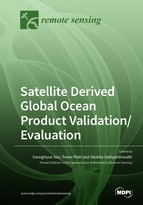Satellite Derived Global Ocean Product Validation/Evaluation
A special issue of Remote Sensing (ISSN 2072-4292). This special issue belongs to the section "Ocean Remote Sensing".
Deadline for manuscript submissions: closed (1 February 2020) | Viewed by 51727
Special Issue Editors
Interests: remote sensing; ocean color; bio-optical algorithms; water quality; phytoplankton productivity; human-/climate-induced changes in marine ecosystems
Special Issues, Collections and Topics in MDPI journals
Interests: the physiological ecology of marine phytoplankton; structure and function of the marine ecosystem; submarine optics; remote sensing of ocean colour; the ocean carbon cycle and climate change, and the ecological approach to fisheries management
Special Issues, Collections and Topics in MDPI journals
Interests: ocean colour modelling; spectral characteristics of light penetration underwater; bio-optical properties of phytoplankton; modelling primary production; bio-geochemical cycles in the sea; climate change; biological–physical interactions in the marine system; ecological provinces in the sea; ecological indicators and phytoplankton functional types
Special Issues, Collections and Topics in MDPI journals
Special Issue Information
Dear Colleagues,
Ocean satellite instruments provide short-term to long-term (hourly to decadal) observations of physical and biogeochemical phenomena and properties in the global ocean at high spatial resolution. Satellite-measured ocean products including sea surface temperature, ocean colour, sea surface salinity, sea surface height, sea surface winds, and sea ice are important data not only for near-real-time ocean monitoring but also for climate data records (CDR) to investigate changes in the ocean environment and manage marine resources for economic, social and environmental benefits. Ocean-observing satellite sensors have been launched recently by international space agencies including NASA, NOAA, ESA and JAXA (e.g., Aquarius, Advanced Microwave Scanning Radiometer 2 (AMSR2), Jason-3, Ocean and Land Colour Instrument (OLCI), Soil Moisture Ocean Salinity (SMOS), Sea and Land Surface Temperature Radiometer (SLSTR), Second Generation Global Imager (SGLI), and Visible Infrared Imaging Radiometer Suite (VIIRS)) and operationally measure the various physical, biological, and biogeochemical variables in the ocean. Validation/evaluation efforts and uncertainty assessments are crucial to providing more accurate satellite-derived ocean products. Validation of the satellite products requires a combination of ground field measurements, instrumented surface sites, inter-satellite comparisons, and research and modeling efforts with robust methodologies.
In this Special Issue, we encourage contributions including, but not limited to, the validation/evaluation of the oceanic radiometric, geophysical and biogeochemical retrievals from various ocean satellite instruments, inter-sensor bias correction, formal error analysis of satellite-observation systems, stability of satellite data and inter-comparison and assimilation of ocean products from multiple sensors.
Dr. SeungHyun Son
Dr. Trevor Platt
Dr. Shubha Sathyendranath
Guest Editors
Manuscript Submission Information
Manuscripts should be submitted online at www.mdpi.com by registering and logging in to this website. Once you are registered, click here to go to the submission form. Manuscripts can be submitted until the deadline. All submissions that pass pre-check are peer-reviewed. Accepted papers will be published continuously in the journal (as soon as accepted) and will be listed together on the special issue website. Research articles, review articles as well as short communications are invited. For planned papers, a title and short abstract (about 100 words) can be sent to the Editorial Office for announcement on this website.
Submitted manuscripts should not have been published previously, nor be under consideration for publication elsewhere (except conference proceedings papers). All manuscripts are thoroughly refereed through a single-blind peer-review process. A guide for authors and other relevant information for submission of manuscripts is available on the Instructions for Authors page. Remote Sensing is an international peer-reviewed open access semimonthly journal published by MDPI.
Please visit the Instructions for Authors page before submitting a manuscript. The Article Processing Charge (APC) for publication in this open access journal is 2700 CHF (Swiss Francs). Submitted papers should be well formatted and use good English. Authors may use MDPI's English editing service prior to publication or during author revisions.
Keywords
- Satellite Remote Sensing
- Ocean Colour
- Sea Ice
- Sea Surface Temperature
- Sea Surface Height
- Sea Surface Salinity
- Validation/Evaluation
- End-to-end error characterisation
- Inter-sensor bias correction
- Stability of satellite data








